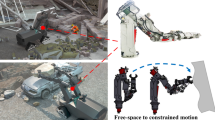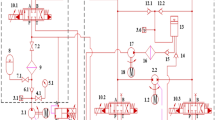Abstract
This study aims to develop an advanced controller for high-accuracy tracking control ofhydraulic manipulators. The primary technical challenges identified in previous research are friction, leakage, external disturbance, and modelling uncertainties. However, this study for the first time discovers that pressure shock disturbance generated by the supply pump significantly impairs the tracking performance of the hydraulic robotic arm. To address these issues, a shock disturbance compensation controller (SDCC) based on backstepping is proposed in this research. A newly developed adaptive controller and compensation controller are used to handling uncertainties and pressure shock disturbance in the hydraulic system, respectively. The controller theoretically guarantees the asymptotic tracking performance of the hydraulic manipulator under uncertainties and mixed disturbances. Extensive comparative experimental results show that the addition of SDCC reduces the maximum tracking error and variance of PID by an average of 68.7\(\%\) and 68.55\(\%\), respectively.










Similar content being viewed by others
Data availibility
The datasets of the current study are available from the corresponding author on reasonable request.
References
Koivumäki, J., Mattila, J.: Stability-guaranteed force-sensorless contact force/motion control of heavy-duty hydraulic manipulators. IEEE Trans. Rob. 31(4), 918–935 (2015)
Ding, R., Cheng, M., Jiang, L., Hu, G.: Active fault-tolerant control for electro-hydraulic systems with an independent metering valve against valve faults. IEEE Trans. Industr. Electron. 68(8), 7221–7232 (2020)
Guo, K., Li, M., Shi, W., Pan, Y.: Adaptive tracking control of hydraulic systems with improved parameter convergence. IEEE Trans. Ind. Electr. 69(7), 7140–7150 (2021)
Li, C., Lyu, L., Helian, B., Chen, Z., Yao, B.: Precision motion control of independent metering hydraulic system with nonlinear flow modeling and compensation. IEEE Trans. Ind. Electr. 69(7), 7088–7098 (2021)
Koivumäki, J., Zhu, W.-H., Mattila, J.: Energy-efficient and high-precision control of hydraulic robots. Control. Eng. Pract. 85, 176–193 (2019)
Sirouspour, M.R., Salcudean, S.E.: Nonlinear control of hydraulic robots. IEEE Trans. Robot. Autom. 17(2), 173–182 (2001)
Mohanty, A., Yao, B.: Indirect adaptive robust control of hydraulic manipulators with accurate parameter estimates. IEEE Trans. Control Syst. Technol. 19(3), 567–575 (2010)
Yao, J., Jiao, Z., Ma, D., Yan, L.: High-accuracy tracking control of hydraulic rotary actuators with modeling uncertainties. IEEE/ASME Trans. Mechatron. 19(2), 633–641 (2013)
Ma, H., Li, Y.: A novel dead zone reaching law of discrete-time sliding mode control with disturbance compensation. IEEE Trans. Industr. Electron. 67(6), 4815–4825 (2019)
Guo, Q., Yin, J., Yu, T., Jiang, D.: Saturated adaptive control of an electrohydraulic actuator with parametric uncertainty and load disturbance. IEEE Trans. Industr. Electron. 64(10), 7930–7941 (2017)
Wang, Z., Qian, Z., Lu, J., Wu, P.: Effects of flow rate and rotational speed on pressure fluctuations in a double-suction centrifugal pump. Energy 170, 212–227 (2019)
Zhao, X., Xiao, Y., Wang, Z., Luo, Y., Cao, L.: Unsteady flow and pressure pulsation characteristics analysis of rotating stall in centrifugal pumps under off-design conditions. J. Fluids Eng. 140(2), 021105 (2018)
González, J., Parrondo, J., Santolaria, C., Blanco, E.: Steady and unsteady radial forces for a centrifugal pump with impeller to tongue gap variation. J. Fluids Eng. 128(3), 454–462 (2006)
Van de Ven, J.D.: Constant pressure hydraulic energy storage through a variable area piston hydraulic accumulator. Appl. Energy 105, 262–270 (2013)
Honkakorpi, J., Vihonen, J., Mattila, J.: Sensor module for hydraulic boom state feedback control. Int. J. Fluid Power 13(3), 15–23 (2012)
Ding, R., Xu, B., Zhang, J., Cheng, M.: Self-tuning pressure-feedback control by pole placement for vibration reduction of excavator with independent metering fluid power system. Mech. Syst. Signal Process. 92, 86–106 (2017)
Bianchi, R., Ritelli, G.F., Vacca, A.: Payload oscillation reduction in load-handling machines: A frequency-based approach. In: Proceedings of the institution of mechanical engineers, Part I: Journal of Systems and Control Engineering 231(3), 199–212 (2017)
Cheng, M., Luo, S., Ding, R., Xu, B., Zhang, J.: Dynamic impact of hydraulic systems using pressure feedback for active damping. Appl. Math. Model. 89, 454–469 (2021)
Deng, W., Yao, J.: Asymptotic tracking control of mechanical servosystems with mismatched uncertainties. IEEE/ASME Trans. Mechatron. 26(4), 2204–2214 (2020)
Guo, Q., Yin, J.-M., Yu, T., Jiang, D.: Coupled-disturbance-observer-based position tracking control for a cascade electro-hydraulic system. ISA Trans. 68, 367–380 (2017)
Guo, Q., Zuo, Z., Ding, Z.: Parametric adaptive control of single-rod electrohydraulic system with block-strict-feedback model. Automatica 113, 108807 (2020)
Zhang, J., Liu, J., Ding, F.: Collaborative optimization design framework for hierarchical filter barrier control suspension system with projection adaptive tracking hydraulic actuator. Nonlinear Dyn. 108(4), 3417–3434 (2022)
Yin, X., Pan, L.: Enhancing trajectory tracking accuracy for industrial robot with robust adaptive control. Robotics Comput-Integr. Manuf. 51, 97–102 (2018)
Ma, H., Guo, J., Wu, J., Xiong, Z., Lee, K.-M.: An active control method for chatter suppression in thin plate turning. IEEE Trans. Industr. Inf. 16(3), 1742–1753 (2019)
Ma, H., Li, Y., Xiong, Z.: Discrete-time sliding-mode control with enhanced power reaching law. IEEE Trans. Industr. Electron. 66(6), 4629–4638 (2018)
Ma, H., Wu, J., Xiong, Z.: A novel exponential reaching law of discrete-time sliding-mode control. IEEE Trans. Industr. Electron. 64(5), 3840–3850 (2017)
Alleyne, A., Liu, R.: On the limitations of force tracking control for hydraulic servosystems. J. Dyn. Sys. Meas. Control. 121(2), 184–190 (1999)
Lischinsky, P., Canudas-de-Wit, C., Morel, G.: Friction compensation for an industrial hydraulic robot. IEEE Control Syst. Mag. 19(1), 25–32 (1999)
Yao, J.: Model-based nonlinear control of hydraulic servo systems: challenges, developments and perspectives. Front. Mech. Eng. 13(2), 179–210 (2018)
Arteaga-Peréz, M.A., Pliego-Jiménez, J., Romero, J.G.: Experimental results on the robust and adaptive control of robot manipulators without velocity measurements. IEEE Trans. Control Syst. Technol. 28(6), 2770–2773 (2019)
Battarra, M., Mucchi, E.: On the relation between vane geometry and theoretical flow ripple in balanced vane pumps. Mech. Mach. Theory 146, 103736 (2020)
Manring, N.D., Fales, R.C.: Hydraulic Control Systems. John Wiley & Sons, New Jersey (2019)
Spong, M.W.: On the robust control of robot manipulators. IEEE Trans. Autom. Control 37(11), 1782–1786 (1992)
Gao, Z.: On the centrality of disturbance rejection in automatic control. ISA Trans. 53(4), 850–857 (2014)
Petrović, G.R., Mattila, J.: Mathematical modelling and virtual decomposition control of heavy-duty parallel-serial hydraulic manipulators. Mech. Mach. Theory 170, 104680 (2022)
Zhu, W.-H., Lamarche, T., Dupuis, E., Jameux, D., Barnard, P., Liu, G.: Precision control of modular robot manipulators: the vdc approach with embedded fpga. IEEE Trans. Rob. 29(5), 1162–1179 (2013)
Humaloja, J.-P., Koivumäki, J., Paunonen, L., Mattila, J.: Decentralized observer design for virtual decomposition control. IEEE Trans. Autom. Control 67(5), 2529–2536 (2021)
Zhu, W.-H.: Virtual Decomposition Control: Toward Hyper Degrees of Freedom Robots, vol. 60. Springer, New Jersey (2010)
Yao, J., Jiao, Z., Ma, D.: Extended-state-observer-based output feedback nonlinear robust control of hydraulic systems with backstepping. IEEE Trans. Industr. Electron. 61(11), 6285–6293 (2014)
Baek, J., Jin, M., Han, S.: A new adaptive sliding-mode control scheme for application to robot manipulators. IEEE Trans. Industr. Electron. 63(6), 3628–3637 (2016)
Funding
This work was supported in part by the National Natural Science Foundation of China under Grant 51975336, in part by the Key Research and Development Program of Shandong Province under Grant 2020JMRH0202, and in part by Shandong Province New Old Energy Conversion Major Industrial Tackling Projects under Grant 2021-13.
Author information
Authors and Affiliations
Corresponding author
Ethics declarations
Conflicts of interest
The authors declare that they have no conflict of interest.
Additional information
Publisher's Note
Springer Nature remains neutral with regard to jurisdictional claims in published maps and institutional affiliations.
Appendices
Appendix A Proof of Theorem 1
Given (23) (24) and (25), we have
Then, we can transform (33) as follows
According to (29), we have
Using Property 1 in [33], the following formula can be obtained
Then, combining (18) and (31), the following equation can be obtained
In view of [40], Property 3 in [33] and (27), we have
We can obtain the following inequalities by using Theorem 1.
Then, by using Young’s inequality, (50) can be deduced that \({{\dot{V}}}_1\left( t\right) \le 0\). Appendix 1 is proven.
Appendix B Proof of Theorem 2
Differentiating \(\mathrm {\Xi }\) yields
Combining (34) and (51), we have
By reusing Theorem 1, The following inequalities can be obtained.
Finally, simplify (52) yields \({{\dot{V}}}_2\le 0\).
Rights and permissions
Springer Nature or its licensor (e.g. a society or other partner) holds exclusive rights to this article under a publishing agreement with the author(s) or other rightsholder(s); author self-archiving of the accepted manuscript version of this article is solely governed by the terms of such publishing agreement and applicable law.
About this article
Cite this article
Sun, Y., Wan, Y., Ma, H. et al. Compensation control of hydraulic manipulator under pressure shock disturbance. Nonlinear Dyn 111, 11153–11169 (2023). https://doi.org/10.1007/s11071-023-08425-7
Received:
Accepted:
Published:
Issue Date:
DOI: https://doi.org/10.1007/s11071-023-08425-7




